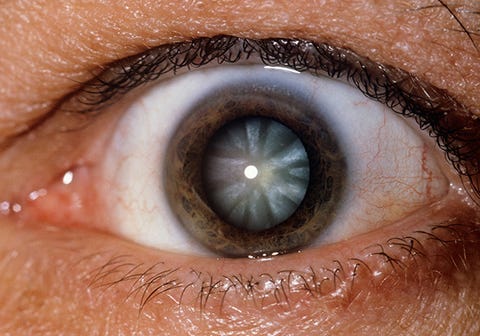How To Enhance Eye Color In Photoshop

Oscar Sanchez Photography/Getty Images
There's more to eye color than meets the…eye. For one, contrary to what you may have learned in grade school, there's more than a single gene involved, which is why your specific hazel hue can look so vastly different from your daughter's, says Rachel Bishop, MD, chief of the consult service section of the National Eye Institute. Though as with skin pigmentation, she says, you'll see eye color similarities among families and ethnicities (dark eyes are more prevalent in an African population than a Scandinavian one, for example).
What's more, whether they're brown, hazel, green, blue, gray, or somewhere in between, your eyes can tell you more about yourself than you might expect—and not just in "the eyes are the windows to the soul" kind of way. Your eye color could dictate your risk for certain diseases or even predict how your body handles booze. Read on to get clued in. (Looking to take back control of your health? Prevention has smart answers—get a FREE trial + 12 FREE gifts.)
1. Dark-eyed people are more likely to have cataracts.
A fogginess appearing over the pupil of the eye is a common sign of cataracts, a clouding of the vision common with aging. And people with dark eyes are at greater risk: A 2000 study published in the American Journal of Ophthalmology found that dark-eyed people had a 1.5 to 2.5 times greater risk of cataracts. Protecting your eyes from ultraviolet rays is one of the crucial steps of cataract prevention for anyone, but the researchers recommend dark-eyed sunbathers take particular caution. (Wearing sunnies and a hat with a brim is a good place to start!)

Science Photo Library/Gety Images
MORE: 10 Cancer Symptoms Most People Ignore
2. Vitiligo is less common among blue-eyed people.
A 2012 review of vitiligo research published in Nature found the autoimmune disease, which causes the loss of skin color in blotches, was less common in people with blue eyes. Of the nearly 3,000 vitiligo patients—who were all Caucasian—involved in the research, 27% had blue eyes, 30% had green or hazel eyes, and 43% had brown eyes, whereas the typical breakdown of eye color among Caucasians is 52% blue, 22% green or hazel, and 27% brown.
The researchers discovered that variations in two particular genes, TYR and OCA2, which play a role in blue eye color, also decrease risk for vitiligo, says study author Richard A. Spritz, MD, director of the genomics programs at the University of Colorado School of Medicine.
3. Melanoma is more common in people with blue eyes.
From a genetic standpoint, "melanoma and vitiligo look like they're opposites," Spritz says. "The same variations we saw as protective for vitiligo increased the risk for melanoma." One theory as to why: vitiligo is an autoimmune disease, meaning our natural immune response mistakenly attacks our own bodies. Over-activity of that response could be what makes brown eyed people more susceptible to vitiligo—and what fights off melanoma, he says. The exact relationship is unknown, but the genes that protect against vitiligo, those that protect against melanoma, and those that simply dictate the amount and type of pigment you're given all seem to be intertwined, he says.
MORE: What Having Skin Cancer Really Feels Like
4. People with dark eyes may be more sensitive to alcohol.
If your eyes are black or brown, you may drink less than your blue- or green-eyed friends, according to a 2001 study published in Personality and Individual Differences. The researchers found higher self-reported alcohol use among women with light eyes as well as more frequent alcohol abuse among a group of light-eyed prisoners who they studied. They hypothesized that dark-eyed folks may be more sensitive to alcohol and other drugs in general, which may lead them to drink less to achieve the desired effects.

Robert Nicholas/Getty Images
5. Women with light eyes may better withstand pain.
In research presented at the American Pain Society's 2014 annual meeting, anesthesiology professor Inna Belfer, MD, PhD, presented findings suggesting women with light eyes may have a higher tolerance for pain and discomfort. A small group of women were studied before and after giving birth, and those with darker eyes exhibited more anxiety and sleep disturbances in response to the pain of the experience. Dark-eyed women also experienced a greater reduction in pain after receiving an epidural, suggesting more sensitivity to pain, MedPage Today reported. Belfer told the Pittsburgh Post Gazette that the results were very preliminary, but could one day help doctors pinpoint a genetic cause of pain.
6. People with light eyes may be more likely to have age-related macular degeneration.
One of the most common causes of vision loss after 50 is age-related macular degeneration or AMD, damage to a small part of the eye near the center of the retina that sharpens your eyesight. It can begin as blurriness and progress to spots that appear completely blank. Several small studies have suggested that, in addition to smoking and a family history of the disease, having light eyes also ups your risk for AMD, perhaps as much as twofold. However, most of these studies have been small, and some question the significance of the findings. AMD is more common among Caucasians, Bishop says, who are also more likely to have pale eyes, but she's not familiar with any research supporting a causal link between the two. It could be an association, she says, such as how African Americans have a higher risk of glaucoma and a higher proportion of dark eyes, but the two may have nothing to do with each other, she says.

Hero Images/Getty Images
MORE: How To Train Your Eyes To See Better
7. Changing eye color could be a sign something's wrong.
If you notice a reddening in the whites of your eyes, you might have undiagnosed allergies. If they turn yellow, you may have liver problems. If just one eye has recently changed color, it could be a sign of inherited diseases like neurofibromatosis, which causes nerve tissue tumors, or Waardenburg syndrome, which typically involves deafness and pale skin, or it could even signal melanoma of the iris, Bishop says.
MORE: 5 Things Your Blood Type Says About You
If your eyes have always been two different colors, it's probably nothing to worry about; there can be slightly different patterns of pigment assigned to each eye during development, Bishop says. But if you notice a recent change, you always want to rule out a problem.
Sarah Klein Sarah Klein is a Boston-based writer, editor, and personal trainer currently with LIVESTRONG.com, and previously of Health.com, Prevention magazine, and The Huffington Post.
This content is created and maintained by a third party, and imported onto this page to help users provide their email addresses. You may be able to find more information about this and similar content at piano.io
How To Enhance Eye Color In Photoshop
Source: https://www.prevention.com/health/a20455257/eye-color-and-health/
Posted by: thomastheactiones.blogspot.com

0 Response to "How To Enhance Eye Color In Photoshop"
Post a Comment